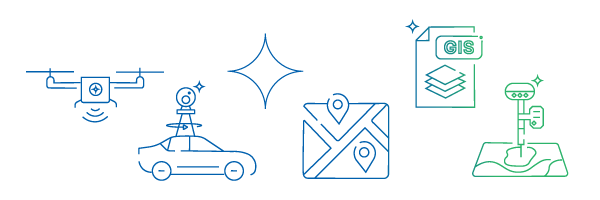In a world where data is the new oil, the line between what’s offline and what’s stored in your computer is fast blurring. Today, every decision is linked to a geography. Whether a company aims to reach more customers or a government plans infrastructure development, there’s always a geographical component that offers significant insight. In such a scenario, merely having data is not enough. What sets you apart is the ability to take that data and transform it into an intelligent and actionable insight. That is where location intelligence comes in.
To define it quickly, Location Intelligence refers to the process of collecting, analysing, and visualising spatial data to extract meaningful insights. These insights can have significant applications for urban authorities, businesses looking to upgrade their logistics and retail expansion as well as disaster preparedness. The insights derived from such systems are aimed at improving efficiency, reducing cost, and enhancing service delivery.
In an India that aims to accelerate, Location Intelligence will offer immense value to government and private bodies alike. At Mapex, we offer the foundation needed to integrate location intelligence into your decision-making infrastructure. With advanced Geographic Information Systems (GIS), spatial analysis tools, and industry-specific dashboards, we help institutions access the power of GIS.
What Is Location Intelligence?
Before we go ahead, let’s understand what Location Intelligence does and offers.
Firstly, the system uses spatial data to uncover patterns, relationships, and trends that standard analysis cannot identify. It combines geographic information (maps, coordinates, satellite imagery) with business data (customer behaviour, asset locations, demographic trends) to support better decision-making.
It helps answer questions such as:
- Where do the majority of service requests originate?
- Which areas experience frequent outages?
- What is the optimal route for logistics?
- Where should the next distribution centre be?
At the heart of location intelligence lies GIS technology. GIS lets users combine different types of data on a map, ask location-based questions, and create clear visuals to support decisions.
Why Indian Organisations Need Location Intelligence
Let’s break down the million-dollar question i.e. why your organisation needs this technology. When we juxtapose India’s ambitions with its challenges, we recognise factors such as vastness, population, and regional diversity and how inefficiency can creep in when managing such a massive landscape. In such a scenario, having insights that help you overcome such intricacies can take you to the promised land. Location Intelligence in the Indian context supports:
-
Urban Growth and Population Density: Currently, about 35% Indians live in cities. The number is expected to climb further in the coming years. Managing urban population, infrastructure (roads, drainage, power lines, housing, water storage) requires constant assessments. Instead of relying on manual data collection and analysis, real-time geospatial insights powered by technology are the future, as they enable transparency and save resources (both temporal and financial).
-
Infrastructure Planning and Maintenance: Organisations such as NHAI and Indian Railways manage extensive physical assets. Without spatial context, tracking asset condition, planning repairs or deploying new infrastructure becomes inefficient. Location Intelligence enables real-time monitoring, predictive planning, and route optimisation.
-
Climate Risk and Disaster Response: India remains vulnerable to floods, droughts, landslides, and cyclones. Identifying high-risk zones and preparing for emergencies requires accurate terrain and weather mapping.
-
Land Governance: Outdated land records and disputed boundaries hinder investments and delay public projects. Cadastral mapping, digitised ownership layers, and property usage data improve transparency.
Core Elements of Location Intelligence

Before we move forward, let’s understand what a Location Intelligence system entails:
-
Data Acquisition: Spatial data comes from satellites, drones, mobile phones, IoT sensors, and surveys.
-
Data Integration: Organisations store data in different formats. Spatial data also exists across varying coordinate systems. A Location Intelligence platform must bring together maps, spreadsheets, APIs, and sensor feeds into one clean, usable system.
-
Geospatial Analysis: Organisations rely on analysis tools to detect patterns, identify hotspots, forecast events, and optimise operations. This component consists of buffer analysis, heatmaps, terrain modelling, and proximity detection.
-
Visualisation: Clear visuals turn complex data into decisions. Whether through dashboards, mobile apps, or web maps, Location Intelligence provides intuitive interfaces..
-
Integration with Enterprise Systems: Organisations operate using ERPs, CRMs, and command centres. Location Intelligence should connect with these platforms. When integrated, the system can automatically flag risks, reroute assets, or generate performance reports based on location.
What Mapex Offers
Mapex provides tailored, scalable, and secure Location Intelligence platforms built for Indian realities. Its core strengths include:
Compatibility with Legacy Systems: Government departments and public sector undertakings often work with legacy IT setups. At Mapexi, we bridge the gap that separates old digital infrastructure from the new-age one.
Custom Dashboards for Different Roles: Senior officials, engineers, field staff, and citizens interact with systems in different ways. Mapex offers role-specific dashboards with clear layouts and action prompts.
Secure and Compliant Deployments: The company offers private cloud hosting, encrypted data storage, and tiered access. These features align with India’s data localisation and security policies.
On-Ground Capacity Building: Tools are only as effective as their users. Mapex conducts training sessions, creates manuals in local languages, and offers user support through helplines and video guides.
Ai-Enabled Spatial Tools: The company applies machine learning to detect patterns, predict anomalies, and automate routine checks. These tools support faster decision-making without losing accuracy.
National Policies and Market Trends Driving LI Adoption
Recent changes in regulation and governance priorities make this the right time to adopt Location Intelligence.
-
The Geospatial Data Guidelines 2021 allow greater private sector access to high-resolution mapping without lengthy approvals.
-
The National Geospatial Policy 2022 sets clear goals for building India into a global geospatial hub by 2030.
-
Schemes such as PM Gati Shakti, Smart Cities Mission, and AMRUT 2.0 have dedicated budgets and guidelines for spatial data use.
-
With over 750 million smartphone users and a rising number of IoT devices, India now generates more location-tagged data than ever before.
How to Start with Location Intelligence
Organisations can take the following steps to begin:
-
Identify a Clear Use Case: Start with an area such as route planning, service coverage, or land boundary validation.
-
Evaluate Existing Data: Mapex assists in assessing data availability and suggests ways to improve data readiness.
-
Choose a Trusted Implementation Partner: Look for a provider with proven experience in Indian conditions and public-sector constraints.
-
Scale from Pilot to Full Rollout: After proving results in one department or region, extend the solution to broader areas or more functions.
Conclusion
Location Intelligence empowers Indian organisations with the spatial insights needed to govern better, serve faster, and plan smarter. Whether in public infrastructure, climate resilience, agriculture, or logistics, LI bridges the gap between data and action.
Mapex stands ready to support this transition. With its deep sector knowledge, secure platforms, and people-first approach, it brings global-quality geospatial solutions adapted for Indian priorities.
For decision-makers in government and enterprise, the question now becomes not just why or what, but where. And the answer often starts with Location Intelligence.





Share this Article :
Published at: 20-08-2025